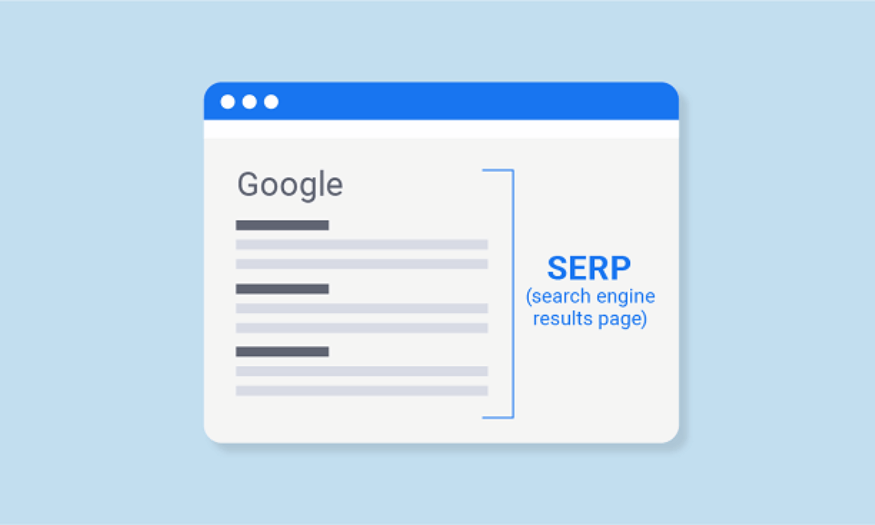Best Selling Products
What is SERP in SEO? Effective SERP analysis tools
Nội dung
- 1. What is SERP?
- 2. The Importance of SERP in SEO
- 3. Common SERP formats
- 3.1 Organic search results
- 3.2 Paid advertising
- 3.3 Featured Snippets
- 3.4 Local search results
- 3.5 Other factors
- 4. Effective SERP analysis tool
- 4.1 Ahrefs
- 4.2 SEMrush
- 4.3 Moz
- 4.4 Google Search Console
- 5. Factors that help optimize website rankings on SERP
- 5.1 SEO Onpage
- 5.2 SEO Offpage
- 5.3 Technical SEO
- 5.4 Content strategy
- 6. Conclusion
In SEO, understanding SERP (Search Engine Results Page) is not only an advantage, but also a decisive factor in your SEO strategy. SERP is not just a search results page, it is also a door to opportunity, where your presence can shape how users access and interact with your content. Let's explore more about SERP and effective analysis tools to help you optimize your website rankings.

In SEO, understanding SERP (Search Engine Results Page) is not only an advantage, but also a decisive factor in your SEO strategy. SERP is not just a search results page, it is also a door to opportunity, where your presence can shape how users access and interact with your content. Let's explore more about SERP and effective analysis tools to help you optimize your website rankings.
1. What is SERP?
SERP (Search Engine Results Page) is the results page that search engines like Google, Bing, and Yahoo display when a user performs a query. Each time you type a keyword into the search box, the SERP returns a list of links, along with additional information such as a description and other rich elements. The structure of the SERP can change depending on many factors, including search keywords, geographic location, and user intent, so understanding the SERP is essential to optimizing content.
SERP research not only helps you identify how your content is being presented, but it also helps you understand current search trends. By analyzing the SERP, you can determine which keywords are being searched for the most and adjust your SEO strategy accordingly. This not only helps improve your website rankings but also optimizes the user experience when they search for information.
2. The Importance of SERP in SEO
SERPs directly affect a website’s visibility. The position of your article on the search results page can determine whether or not users will click on your link. A high position in the SERP means more people will see your content, increasing your chances of attracting traffic and building your brand. This is especially important in a competitive online world where user attention is precious.
Additionally, rich SERP elements like featured snippets, images, or videos not only make the results page more appealing, but can also increase your site’s click-through rate. These elements help your content stand out from your competitors, giving you a better chance of grabbing users’ attention and leading to more traffic.
Finally, tracking and analyzing your website’s SERP rankings is an important part of your SEO strategy. By evaluating the performance of different keywords, you can identify areas for improvement and adjust your content accordingly. This not only helps with SEO optimization, but also ensures that you’re on track to increasing your website’s traffic and revenue.
.png)
3. Common SERP formats
3.1 Organic search results
Organic search results are links to websites that are ranked based on their relevance to a user’s query, not paid results. They are the main component of the SERP and often take up the majority of the display space. To get a good position in this list, websites need to optimize their content effectively and efficiently.
Some of the key factors that influence organic rankings include valuable content, on-page optimization techniques, quality backlinks, and user experience. This means that to be successful in SEO, you need to not only create great content, but also understand how search engine algorithms work.
.png)
3.2 Paid advertising
Paid ads, commonly known as Google Ads, appear prominently in the SERP, often at the top or bottom of the page and are clearly marked. These ads allow businesses to quickly reach potential customers without having to wait for organic rankings. However, not all ads can rank highly; it depends on the budget and quality of the ad.
Even though it is paid content, ads still need to be relevant to user queries to deliver the best experience. This means advertisers need to carefully research keywords and target audiences to optimize their campaigns.
3.3 Featured Snippets
Featured snippets are one of the most engaging formats on the SERP, appearing at the top of the page and providing short, concise information that quickly answers a user’s question. Common types of featured snippets include text, bulleted or numbered lists, tables, and videos. Appearing in a featured snippet can boost a website’s visibility and authority.
Being selected as a featured snippet source not only increases traffic, but also establishes your position in the industry you operate in. This is especially valuable for building your brand and establishing trust with consumers.
.png)
3.4 Local search results
When you search for something with a local element, such as “milk store near me,” Google returns local search results, often with maps and detailed information about businesses in the area. This makes it easy for users to find the services or products closest to them.
For businesses with physical stores, optimizing for local search is extremely important. This not only helps attract local customers but also creates sustainable growth opportunities for the business.
3.5 Other factors
In addition to the main formats mentioned above, SERPs can include many other components, depending on the user's query. For example, a Knowledge Panel provides an overview of a topic, often appearing on the right side of the SERP. Image carousels display a range of images relevant to the search, while video results are highlighted when there is relevant video content.
Featured news and “People Also Ask” sections are also important elements that help users access information quickly and effectively. These formats not only enrich the SERP but also create a better search experience for users.
.png)
4. Effective SERP analysis tool
4.1 Ahrefs
Ahrefs is one of the leading SERP analysis tools, known for its ability to provide detailed data on keyword rankings and SEO performance. Users can track the fluctuations of keyword rankings over time, giving them a better understanding of how their content is performing in search engines. Additionally, Ahrefs also allows you to analyze backlinks, helping you identify which resources are linking to your website and assess their quality.
Another strength of Ahrefs is its competitive analysis. You can easily compare your website’s SEO performance with your competitors, learn valuable lessons, and adjust your strategy accordingly. By understanding the keywords your competitors are ranking for, you can optimize your content to compete more effectively.
Finally, Ahrefs provides intuitive and easy-to-understand reports that help users grasp information quickly. With a friendly interface and many powerful features, Ahrefs is an ideal choice for both beginners and SEO experts.
.png)
4.2 SEMrush
SEMrush stands out for its keyword position tracking and SERP features analysis. Not only does it allow you to track your keyword rankings, it also provides insights into other elements on the search results page, such as featured snippets, tables, and videos. This helps you better understand how your content compares to your competitors and make the necessary adjustments to optimize your SERP position.
SEMrush also offers a range of competitor analysis tools that allow you to look at the keywords they are ranking for and their content strategy. This way, you can spot untapped opportunities and improve your content to attract more traffic.
In addition, SEMrush also has features such as backlink analysis and website SEO health check. With this valuable information, you can easily optimize your SEO strategy and achieve better results on search engines.
4.3 Moz
Moz is a comprehensive SEO analysis tool that provides detailed reports on your website’s SEO performance and domain authority analysis. One of the notable features of Moz is its ability to measure the trustworthiness and reputation of a website through the Domain Authority (DA) metric. This metric not only helps you assess your position in the industry but also helps you identify opportunities to increase your website’s authority.
Moz also offers powerful keyword analysis tools that allow you to search for and track rankings for the keywords you’re targeting. This is helpful in determining which keywords are bringing in the most traffic and adjusting your content strategy accordingly.
Additionally, Moz has a strong support community where users can share their experiences and find solutions to problems encountered during SEO optimization. With an easy-to-use interface and rich features, Moz is a great choice for those who want to improve their website's SEO performance.
4.4 Google Search Console
Google Search Console is an extremely useful free tool that Google offers to webmasters and SEO professionals. It helps you monitor your website’s search performance, allowing you to see the keywords your site is ranking for, the number of clicks, and the click-through rate (CTR). This helps you evaluate the effectiveness of your current SEO strategies and identify opportunities for improvement.
One of the standout features of Google Search Console is its ability to detect technical issues on your website. This tool helps you identify errors like broken links, page speed issues, and other issues that can impact user experience. By fixing these issues, you can improve your site’s ranking and visibility on SERPs.
Finally, Google Search Console offers local search performance reports, which help you track how users in your area are searching for information related to your business. This is especially important for businesses with physical stores, helping to optimize your local marketing strategy effectively.
.png)
5. Factors that help optimize website rankings on SERP
5.1 SEO Onpage
On-page SEO is a solid foundation for any SEO strategy. To optimize your article on-page, the first thing you need to do is to use your main keywords wisely in the title, URL, and heading tags. This not only helps search engines understand the content but also attracts the attention of readers.
Additionally, writing a compelling meta description that includes keywords and a call to action will increase click-through rates. Optimizing images with appropriate alt text is also important, as it not only improves SEO but also helps users when images fail to load. Finally, make sure that your content structure is clear with short, easy-to-read paragraphs, and that your website is mobile-friendly for the best user experience.
5.2 SEO Offpage
Off-page SEO focuses on building your website’s authority and trustworthiness from outside sources. To do this effectively, you need to create quality content that others want to share. Engaging content will generate interest and increase the likelihood of links from other sites.
Guest posting on authoritative websites in your industry is also an effective strategy. This not only helps you build relationships with bloggers and experts in your field, but also provides you with valuable links. Additionally, leveraging social media to promote your content is a great way to increase your online presence and attract more users.
5.3 Technical SEO
Technical SEO plays an important role in ensuring that your website is easily crawled and indexed by search engines. Some of the points to keep in mind for optimizing technical SEO include page load speed. A fast loading website not only improves user experience but also gets a boost in rankings.
At the same time, your URL structure should be SEO-friendly, helping search engines understand the content of each page. Using Schema markup is a great way to give Google more information about your content. Don’t forget to create and submit an XML sitemap so search engines can easily find your pages. Finally, fix technical errors like broken links and redirect loops to ensure users can navigate your site smoothly.
5.4 Content strategy
Quality content is the key to engaging users and improving SERP rankings. To create effective content, always aim to meet the needs and solve the problems of your readers. Content should not only be attractive but also valuable and accurate.
Building a content strategy that is relevant and in-depth in your industry will help Google see your website as an expert. This will facilitate the display of articles in higher rankings. Additionally, regularly updating old content with new and valuable information will keep your website fresh and engaging.
.png)
6. Conclusion
SERP (Search Engine Results Page) plays an important role in SEO strategy, directly affecting the visibility and traffic of the website. Understanding the formats and elements that make up SERP not only helps you optimize content but also improves user experience. In addition, using SERP analysis tools such as Ahrefs, SEMrush, Moz and Google Search Console will provide you with valuable data to track performance and adjust your strategy effectively.












































